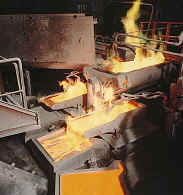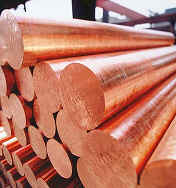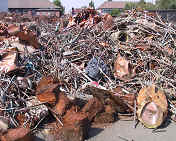COPPER (Cu)
History
The name copper comes from the Latin "aes cyprium" – ore from Cyprus. It is one of the oldest metals in human history and is considered the oldest utility metal. The Egyptians already used solid copper objects around 4800 B.C. Today, copper is the most important non-ferrous metal together with aluminium. World production sums up to 20 Mio t in 2013. |
|
Occurrence
In nature copper rarely can be found as pure metal but in minerals, with the best known being azurite, chalcopyrite and malachite. Copper minerals usually occur together with other metals such as iron, lead, gold and silver. The largest copper deposits are to be found in Chile and in the USA, which each account for around 20% of the world's reserves of 500 million tonnes. Other important copper mining areas are Africa, Canada and the CIS countries. The Mansfeld deposits (Mansfeld copper slates) are the largest deposits to be found in Germany, but these mines have meanwhile been closed down. Other mines were located in Goslar (Harz) and Meggen (Sauerland). Nowadays ther are exploration activities in the Lausitz region (Germany). The biggest operating European mining area is in Poland. |
|
Physical-chemical properties
Copper is a relatively soft, ductile, red metal. When exposed to air it rapidly forms a thin, protective oxide layer which prevents any further reactions (Patina). The metal is known for its outstanding electrical and thermal conductivity and is therefore a popular choice as cable material for current conduction. Only silver has even better properties in this respect. |
|
Health
Copper is a vital trace element. It is involved in biological energy production in the body cells, it helps to form the red haemoglobin and is responsible for essential functions in the metabolism of the bones and central nervous system. It cannot be stored in the body but is excreted constantly, so that the human body always has to be provided with a constant intake in the diet. Plants depend on copper for healthy growth. |
|
Applications / Products
Copper is indispensable in electrical engineering and electronics, thanks to its excellent conductive properties. It is used as a conductive material in cables, generators and transformers. Conductors of copper allow for further miniaturisation and performance enhancement in chips. In vehicles, copper is used among others for brake lines and electric drives, in the building industry it is used as roofing, buttering and façade material. Thanks to its resistance characteristics and health properties, for a long time now copper pipes have been used for the public drinking water supply and also for central heating systems. Copper hinders the growth of many bacteria so that it is used in copper zinc alloys (brass) in public buildings and in public transport for handles and door fittings to prevent the transfer of germs. |
|
Economical significance
A good 20 million tonnes of the red metal are used all over the world every year, including around4 million tonnes in the EU-25. The secondary industry is growing in significance, because more than 45% of copper production comes from scrap and interim products containing copper (slag, dross, etc.) |
|
Recycling
The recycling of copper can be considered as the largest, most economical copper mine, and was already taken for granted in ancient times. The product-related recycling rate meanwhile exceeds 90%. Like all other nonferrous metals, copper can go through the cycle of primary production, manufacturing, use and recycling without any loss in quality. In this way, the copper industry makes an essential contribution to environment protection and to sustainability. |





